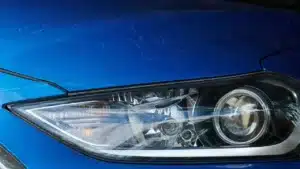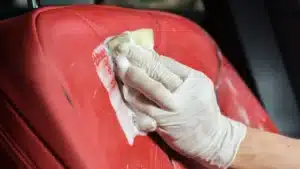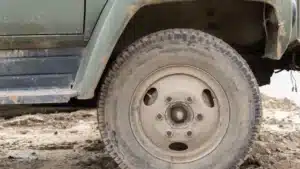No matter how hard you try to keep the interior of your car clean, stains seem to find a way to pop up out of nowhere and blemish your car’s upholstery. Whether it’s ketchup from a burger, pop, water, or slime – stains have an unsightly appearance. This article will discuss how to remove one type of stain, in particular – water.
There’s a common misconception that water stains caused by water bottles or rain will just evaporate and not affect the upholstery. However, this isn’t true. Keep reading to learn how to get water stains out of car seats to keep the inside of your car looking clean and fresh. Read more about How to Remove Water Stains from Car Glass?

Why does water stain car seats?
When water evaporates on surfaces such as on your upholstered car seats, it leaves behind mineral deposits. This causes unsightly dark stains on the upholstery.
The ease of removing water stains often depends on the severity of the water damage. For example, a small spill from a water bottle is much easier to remove than a seat that was drenched with rainwater after you accidentally left the window down overnight.
In either case, don’t waste time having the water stains removed. The fresher the water spots, the easier the stains are removed.
Materials needed to remove water spots from car seat upholstery
Fortunately, you can remove water stains from your car’s seats with a few simple materials and a little elbow grease.
Gather the following items:
- Vacuum cleaner. It doesn’t need to be a special vacuum cleaner. Find one that has an attachment.
- Water
- Vinegar
- Upholstery cleaner
- Soft brush
- Microfiber cleaning towels
How to get water stains out of car seats
Now that you’ve gathered all of your items, it’s time to get to work. This is how to remove water stains from car seat upholstery:
Vacuum thoroughly
Before trying to remove the water stains, use an attachment on your vacuum to clean the area of any dirt, dust, crumbs, or debris, which can make the stain worse if they blend into the area. Removing these items will also make it easier to effectively clean the area.
Use vinegar for darker stains
For darker stains, consider applying a teaspoon of vinegar to the affected area. Then, use a microfiber towel and gently rub the vinegar onto the area. Wait 5-10 minutes before moving to the next step.
This step is especially effective for saltwater and hard water stains. A mixture of water and white vinegar is also a good way to remove water stains from car glass.
Apply the upholstery cleaner
The next step is the most important. Find the appropriate car upholstery cleaner for the type of material your car seats are made of; different types of upholstery can include cloth, leather, suede, and vinyl.
Most types of upholstery cleaners work on several different types of material, although you will need a dedicated cleaner for leather car seats.
We recommend using the upholstery cleaner on the entire seat instead of just targeting the area with the water stains. That way, the area you clean will match the rest of the seat.
Use a soft brush to gently apply the upholstery cleaner onto the fabric. Once you’ve thoroughly shampooed the seat, soak up the shampoo and water with a towel or cloth.
Dry the seat
After you’ve finished soaking up the shampoo and water, allow the seat to dry for several hours. You can accelerate the process by rolling down all of the car’s windows (just make sure it’s not raining!)
How to prevent water stains on your car’s upholstery?
You can take preventative measures to avoid water stains on your car’s seats by installing high-quality car seat covers on all of your seats.
If water, other beverages, or food are spilled on the seat, you can simply put the seat cover in the washer and reapply it once it’s clean. This is a great idea, especially when you have kids in the car or are taking a long road trip.
If you’re picking up other adults for a night out on the town and want to show off your car’s upholstery, simply remove the seat covers and place them in the trunk until you’re ready to use them again.
It’s a good idea to roll your car’s windows up, even on a sunny day. You never know when a pop-up storm will arrive, causing rainwater to get into your car and on the seat’s upholstery.
FAQ
How do you get water stains out of cloth car seats?
The best way to remove water stains from cloth car seats is to apply a teaspoon of vinegar to the stain and then use a soft brush to rub the upholstery cleaner onto the entire seat. For minor stains, you can consider skipping the vinegar step.
How do you get water stains out of leather car seats?
To remove water stains from leather car seats, consider using a mixture of vinegar and room-temperature water. You can also try a leather cleaner or a little rubbing alcohol.
Are water stains permanent?
Unless the water damage is extensive, most water stains can be removed from car upholstery by using an upholstery cleaner recommended for the type of material that’s stained or by rubbing a teaspoon of vinegar into the affected area.
Does baking soda remove couch stains?
Baking soda is a great solution to remove odors and stains from couches. A solution of water and baking soda can penetrate deep into a stain to absorb it. Let the solution sit for about 20 minutes, then vacuum or wipe it away.
How do you get stains out of waterproof material?
You can remove stains from waterproof materials by using either a liquid detergent or a mixture of water and vinegar. Avoid using powdered detergents or stain removers.
Conclusion
If you lead a busy life and have kids, you probably have a lot of meals on the go while you’re driving from place to place. This can lead to spills and unsightly water stains. It’s important to act fast when you notice water damage to your upholstery to give yourself the best chance of removing the stain.
Removing water stains from car seat upholstery is a rather easy task that takes less than an hour (not including the drying time) and can be done with a few materials you probably already own at your home. Once you’re finished, you’ll be happy that your car’s upholstery has been restored to new-like conditions.
Related Content:



